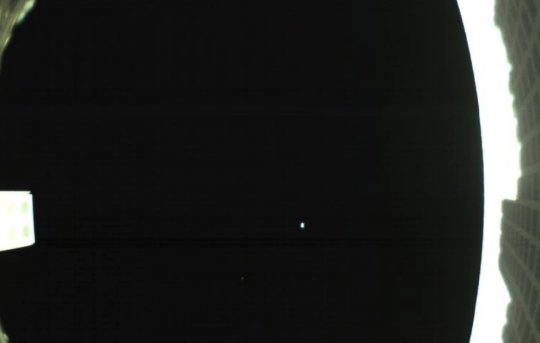Paul Gilster's Blog, page 106
May 30, 2018
Star Formation at ‘Cosmic Dawn’
When life first arose in the universe is a question to which we have no answer. A key problem here is that without knowing how rare — or common — life’s emergence is, we can’t draw conclusions about where (or when) to find it. One thing that is accessible to us, though, is information about when stars began the process of producing the elements beyond hydrogen and helium that are constituents of our own living systems. And on that score, we have interesting news from an international team of scientists about extremely old galaxies.
Led by Takuya Hashimoto and Akio Inoue (Osaka Sangyo University), the researchers have gone to work on a galaxy known as MACS1149-JD1, using data acquired from the Atacama Large Millimetre/Submillimetre Array (ALMA) and the European Southern Observatory’s Very Large Telescope (VLT). The team’s paper in Nature confirms that the galaxy is some 13.28 billion light years away. Thus we see it as it appeared when the universe was about 500 million years old. Another galaxy, GN-z11, has been measured at 13.4 billion light years using data from the Hubble Space Telescope.
But the Hubble data offer a less precise measurement than Hashimoto and Inoue found, because the distance to MACS1149-JD1 is based on two independent emission lines from atoms of hydrogen and oxygen, and therein lies a tale. This is the most distant known source of oxygen ever detected. It implies that this galaxy contains stars that formed using elements produced in a still earlier generation of stars whose death produced heavier elements. Here’s what second author Nicolas Laporte (University College London) has to say on this:
“This is an exciting discovery as this galaxy is seen at a time when the Universe was only 500 million years old and yet it already has a population of mature stars. We are therefore able to use this galaxy to probe into an earlier, completely uncharted, period of cosmic history.”
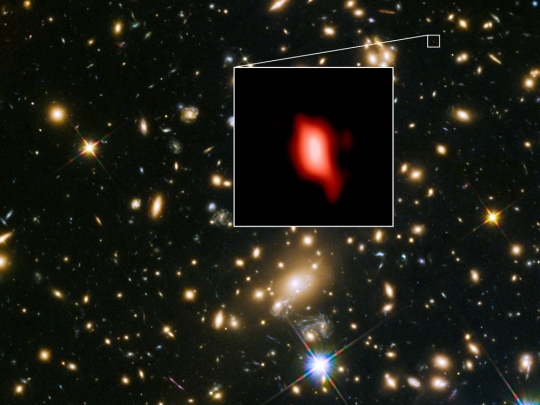
Image: Galaxy MACS1149-JD1 located 13.28 billion light-years away imaged with the NASA/ESA Hubble Space Telescope. The first zoom shows how the galaxy was observed with the ESO VLT centred on a rectangular slit. The final zoom shows the Hubble image with contours of ionized oxygen detected by ALMA. Credit: ALMA (ESO/NAOJ/NRAO), NASA/ESA Hubble Space Telescope, Hashimoto et al.
But let’s pause for a moment to remind ourselves of how tricky it is to calculate distances for objects at the edge of the visible universe. Here I’m quoting from the National Astronomical Observatory of Japan’s website on the matter:
…the distances to astronomical object beyond about a couple billion light-years are estimated using redshift — a change in the wavelength of light from the object. The relation between the redshift and the distance depends on the history of the Universe: how fast (or slow) the Universe has been expanding. This is determined by models (based on physics) and certain characteristic parameters. These parameters are still being determined, so their estimated values change from year to year. Also, there are different ways to define distances (co-moving distances, luminosity distances, …), which give different values. Because of the complexity, sometimes different astronomers find different distances for the same object.
With that in mind, we can proceed to Laporte, who detected hydrogen emissions from MACS1149-JD1 using the Very Large Telescope, producing an independent confirmation of the distance Hashimoto and Inoue had deduced from their ALMA data (both using, in NAOJ’s words, ‘cosmological parameters given in the most recent published results by the major collaborations’). In the ALMA work, the signal of ionized oxygen had been stretched from the infrared down to microwave wavelengths by the continuing expansion of spacetime.
Both Laporte and the Hashimoto/Inoue team have run up a history of detecting the most distant known sources, with Laporte responsible for an earlier detection of oxygen at 13.2 billion light years. What we wind up with the new paper is evidence for star formation at an even earlier period, some 250 million years after the Big Bang, meaning that galaxies existed at times earlier than we can currently detect them. Co-author Richard Ellis (University College London) notes the implications for life:
“Determining when cosmic dawn occurred is akin to the `Holy Grail’ of cosmology and galaxy formation. With MACS1149-JD1, we have managed to probe history beyond the limits of when we can actually detect galaxies with current facilities. There is renewed optimism we are getting closer and closer to witnessing directly the birth of starlight. Since we are all made of processed stellar material, this is really finding our own origins.”
Are these likewise the origins of other living things in the cosmos? My assumption is that the answer is yes, but without confirmatory data, that thought can be no more than a speculation.
The paper is Hashimoto et al., “The onset of star formation 250 million years after the Big Bang,” Nature 557 (2018), 392-395 (abstract).






May 29, 2018
Pluto: A Cometary Formation Model
The ongoing work of mining New Horizons’ abundant data from the outer system continues at a brisk pace. But missions occur in context, and we also have discoveries made at comet 67P/Churyumov-Gerasimenko by the European Space Agency’s Rosetta probe to bring to bear. The question that occupies Christopher Glein and Hunter Waite (both at SwRI) is how to explain the chemistry New Horizons found at Pluto and what it can tell us about Pluto’s formation.
At the heart of their new paper in Icarus is the question of Pluto’s molecular nitrogen (N2), which plays a role on that world similar to methane on Titan, water on Earth and CO2 on Mars. All are volatiles, meaning they can move between gaseous and condensed forms at the temperature of the planet in question. We’ve learned that solid N2 is the most abundant surface ice visible to spectroscopy on Pluto, as witness the spectacular example of Sputnik Planitia.
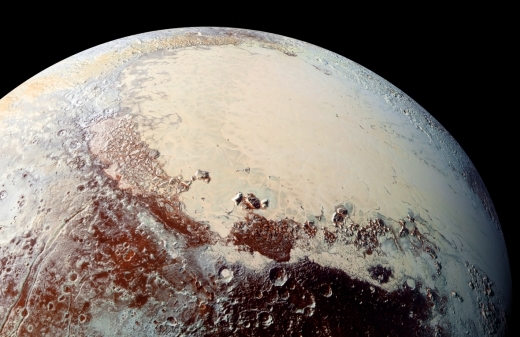
Image: NASA’s New Horizons spacecraft captured this image of Sputnik Planitia — a glacial expanse rich in nitrogen, carbon monoxide and methane ices — that forms the left lobe of a heart-shaped feature on Pluto’s surface. SwRI scientists studied the dwarf planet’s nitrogen and carbon monoxide composition to develop a new theory for its formation. Credit: NASA/Johns Hopkins University Applied Physics Laboratory/Southwest Research Institute.
Anyone glued to their screen during New Horizons’ 2015 flyby will recall the surprise generated by Sputnik Planitia’s youthful terrain, now believed to be the result of the flow of solid N2. Scientists also found that nitrogen can sublimate at Pluto’s surface, so we have a volatile cycle that causes surface pitting and frosts, one that likewise accounts for the existence of Pluto’s atmosphere. Given the importance of nitrogen, the issue of its origin looms large because of what it can tell us about Pluto’s formation, and by extension that of other outer system objects.
Here the crossover with the Rosetta data is helpful. What Glein and Waite are suggesting is that Pluto may owe its existence to comets, accumulating the N2 observed by New Horizons through accretion. Says Glein, with a nod to the nitrogen-rich ice of Sputnik Planitia:
“We’ve developed what we call ‘the giant comet’ cosmochemical model of Pluto formation. We found an intriguing consistency between the estimated amount of nitrogen inside the glacier and the amount that would be expected if Pluto was formed by the agglomeration of roughly a billion comets or other Kuiper Belt objects similar in chemical composition to 67P, the comet explored by Rosetta.”
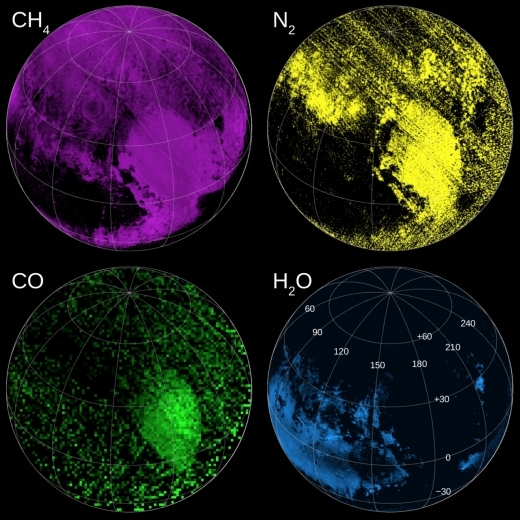
Image: New Horizons not only showed humanity what Pluto looks like, but also provided information on the composition of Pluto’s atmosphere and surface. These maps — assembled using data from the Ralph instrument — indicate regions rich in methane (CH4), nitrogen (N2), carbon monoxide (CO) and water (H2O) ices. Sputnik Planitia shows an especially strong signature of nitrogen near the equator. SwRI scientists combined these data with Rosetta’s comet 67P data to develop a proposed “giant comet” model for Pluto formation. Credit: NASA/Johns Hopkins University Applied Physics Laboratory/Southwest Research Institute.
Whether Pluto formed from the accretion of cometary ices or from materials with a chemical composition closer to that of the solar nebula remains an open question, with the paper addressing both possibilities and finding both to be consistent with the data. Tangled up with the question is the issue of carbon monoxide (CO) and the low CO/N2 ratios observed at Pluto. The problem is that these ratios should be much higher than what we find in Pluto’s atmosphere. How to explain the missing carbon monoxide?
There are implications here for what may still lie beneath the icy world’s surface. From the paper:
…we have performed aqueous geochemical calculations showing the great thermodynamic instability of CO dissolved in cold (liquid) water, even for a restricted metastable equilibrium system… The destruction of CO to formate or carbonate species… would be strongly favored if Pluto has or had a subsurface ocean. This mechanism can be applied to the cometary model, but not to the solar model as the CO/H2O ratio is too large in the latter. Hence, the cometary model seems preferable, with more options to reconcile the CO/N2 ratio.
And implications for Pluto’s continuing surface activity are also present:
We note that the burial and aqueous destruction hypotheses for missing CO are not necessarily mutually exclusive. A major implication of these processes is that the observed composition of Pluto cannot be completely primitive, even if its N2 is indeed primordial. This resonates with the dynamic geology seen by New Horizons (Moore et al., 2016).
Numerous questions remain to be answered, but the authors propose an evolutionary scenario that begins with Pluto accumulating cometary nitrogen and CO, with subsequent interactions accounting for loss of the CO and outgassing of N2. This takes into account the surface accumulation of the latter at Sputnik Planitia and cometary ‘resupply’ of a small amount of CO that mixes with surface nitrogen. This is one of various possible scenarios, but it is consistent with the data the paper examines and points to future work.
Among many questions remaining, the issue of how much N2 might be inside Pluto looms large, as does its distribution in the crust, rocky core and possible liquid water ocean. We’d also like to know whether the abundance of N2 found at comet 67P is representative of the cometary population at large and of larger icy Kuiper Belt Objects.
And among ten questions posed by the authors in their conclusion, this one is significant: Why do we lack any detection of CO2 on Pluto while finding it on Triton, and is there a consistent way of resolving the question with regard to the lack of CO on both bodies? This gets us into the broad issue of the mechanisms that provide volatiles to worlds like these. Check the paper’s conclusion for a useful wrap-up of future directions to be taken with the New Horizons data, and the areas where new data will be required.
The paper is Glein and Waite, “Primordial N2 provides a cosmochemical explanation for the existence of Sputnik Planitia, Pluto,” Icarus Vol. 313 (October, 2018), pp. 79-92 (abstract / preprint).






May 24, 2018
Administrative Item
Some of you may have noticed a blip in the comments moderation over the past 24 hours. I think all messages have now come through, but a software upgrade on my server is the culprit. Things seem to have gone back to normal now.
On an unrelated matter, I won’t be able to get off a post today or tomorrow. On Monday, I’ll have some interesting information about Breakthrough Starshot.






May 23, 2018
TESS: The View into the Galactic Plane
I want to be sure to get the first image from TESS, the Transiting Exoplanet Survey Satellite, into Centauri Dreams, given the importance of the mission and the high hopes riding on it as the next step in exoplanet exploration. Now we move from the Kepler statistical survey methodology to a look at bright, nearby stars, and plenty of them. TESS will cover an area of sky far larger than the amount of sky we see in this image, which looks out along the plane of the galaxy from a perspective that matches southern skies on Earth.
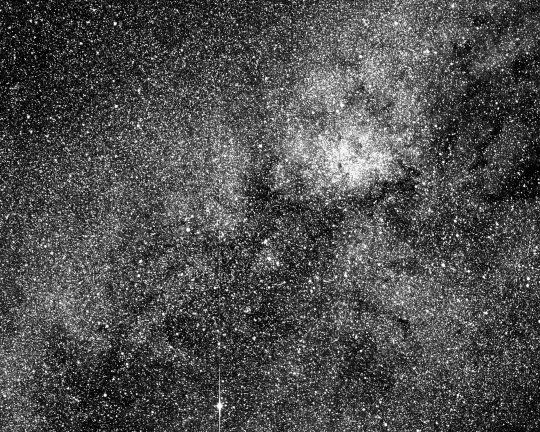
Image: This test image from one of the four cameras aboard the Transiting Exoplanet Survey Satellite (TESS) captures a swath of the southern sky along the plane of our galaxy. TESS is expected to cover more than 400 times the amount of sky shown in this image when using all four of its cameras during science operations. Credits: NASA/MIT/TESS.
Showing some 200,000 stars, the image is centered on the southern constellation Centaurus, with a bit of the Coalsack Nebula at the upper right and, if you look along the bottom edge, the bright star Beta Centauri readily visible. Here I add the usual caution that Beta Centauri has nothing to do with Alpha Centauri — it is a separate place and interesting in its own right. About 400 light years out, this is, like Alpha Centauri, a triple system, and with Alpha Centauri, it serves as one of the pointer stars to the lovely asterism known as the Southern Cross.
While a triple system, Beta Centauri’s component stars are nothing like the G-class Centauri A, K-class Centauri B and M-dwarf Proxima Centauri. At Beta Centauri we have a close binary consisting of two B-class stars orbiting each other over a period of 357 days, both stars thought to be variables now evolving off the main sequence. Orbiting the binary is Beta Centauri B at about 100,000 AU, another B-class star with an orbital period of about 1500 years.
This first TESS image is a test of the spacecraft’s four cameras, with a science-quality image expected to be released in June. Meanwhile, the spacecraft is easing into its highly elliptical orbit, with a final thruster burn scheduled for May 30. Science operations should commence in mid-June once orbital adjustments and camera calibrations are completed.
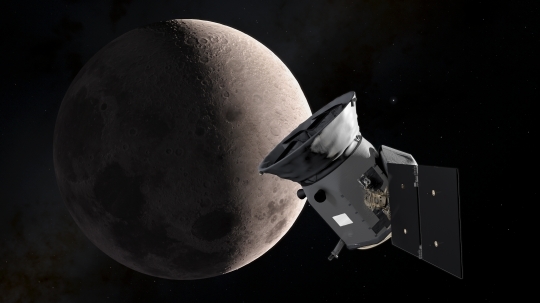
Image: An illustration of TESS as it passed the Moon during its lunar flyby. This provided a gravitational boost that placed TESS on course for its final working orbit. Credit: NASA’s Goddard Space Flight Center.
This first story on an operational TESS gives me echoes of New Horizons, which we followed here from launch to Pluto and now on to MU69 and whatever KBO may be next. Some people caution against anthropomorphizing machines, a human tendency when we deal with our pets, applying human perspectives to creatures considerably different than ourselves. To me the distinction is meaningless. We apply our passions and values to the things that matter to us, and New Horizons and TESS fit that bill for me. I recognize that spacecraft are not ‘creatures’ but my own values of commitment and purpose ride with these machines that can feel neither.






May 22, 2018
Is Asteroid 2015 BZ509 from another Stellar System?
It’s conceivable that getting humans to an interstellar object may not involve journeying all the way to another star. We’ve learned that wandering asteroids and comets move between stars, as the case of ‘Oumuamua demonstrated, and early research offers the possibility that such objects exist in large numbers. Now we have (514107) 2015 BZ509, which is conceivably an interloper into our system of another sort. Two researchers believe that this asteroid near the orbit of Jupiter is not just passing through, but a captured object from another stellar system.
A comparison with Triton seems apt. One of the most compelling pieces of evidence that Neptune’s largest moon is actually a Kuiper Belt Object is its retrograde orbit. We see the same thing with 2015 BZ509, and for Fathi Namouni (Observatoire de la Côte d’Azur) and Helena Morais (Universidade Estadual Paulista), that sends a clear message. The researchers have offered their work in a new paper in Monthly Notices of the Royal Astronomical Society.
“How the asteroid came to move in this way while sharing Jupiter’s orbit has until now been a mystery,” explains lead author Namouni. “If 2015 BZ509 were a native of our system, it should have had the same original direction as all of the other planets and asteroids, inherited from the cloud of gas and dust that formed them.”
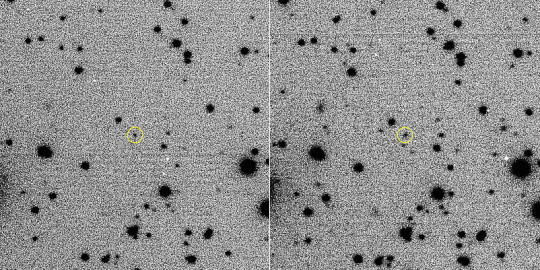
Image: Images of 2015 BZ509 obtained at the Large Binocular Telescope Observatory (LBTO) that established its retrograde co-orbital nature. The bright stars and the asteroid (circled in yellow) appear black and the sky white in this negative image. Credit: C. Veillet / Large Binocular Telescope Observatory.
Namouni and Morais used computer simulations to track the errant asteroid back in time, arguing that 2015 BZ509 has moved this way since the birth of the Solar System some 4.5 billion years ago, an indication that it could not have formed there originally. The case also relies on the fact that the Sun formed in a tightly packed star cluster where movement of objects ejected by gravitational forces within their own system into orbits around other stars would not have been uncommon. Thus this rogue asteroid may well contain information about planet formation and evolution as well as telling us more about the Sun’s original siblings.
So what exactly do we know about this object? 2015 BZ509 is in a resonant, co-orbital motion with Jupiter and represents the first discovery of a retrograde co-orbital asteroid with Jupiter or any other planet. Its orbital eccentricity of 0.3805 takes it inside and then outside of Jupiter’s orbit at its closest approaches (176 million kilometers). The orbital period is 11.65 years and the inclination is 163 degrees, an evidently stable orbit if a complicated one.

Image: Stellar nursery NGC 604 (NASA/HST), where star systems are closely packed and asteroid exchange is thought to be possible. Asteroid (514107) 2015 BZ 509 may have emigrated from its parent star and settled around the Sun in a similar environment. Credit: NASA / Hubble Heritage Team (AURA/STScI).
I’ve long speculated in these pages about interstellar missions that operate not by making fast jumps to other stellar systems but by moving incrementally over thousands of years, taking advantage of the fact that the Oort Cloud extends tens of thousands of AU, if not more, from the Sun. If similar debris were found around nearby stars, a patient species evolving new technologies and biologies as it progressed could simply ‘walk across’ to the next system.
Now we’re learning that we may be able to study interstellar materials without going nearly as far. We’re nowhere near ready to send humans into Jupiter space, but if this work is confirmed, then targets like (514107) 2015 BZ 509 will inevitably receive future visitors. We have so much to learn about how common objects like these are, but the researchers believe the number could be high.
In the passage from the paper below, the term ‘polar corridor’ refers to objects pushed into polar inclinations all the way out to the Oort Cloud. The ‘clones’ refer to the computer simulations Namuni and Marais conducted, simulating the evolution of one million clones of 2015 BZ 509:
The one million clone simulation provides further evidence that there are currently more extrasolar asteroids in the Solar system. In effect, if more objects were captured along [with] 2015 BZ509 by Jupiter early in the Solar system’s history, the less stable orbits must have left the co-orbital region by way of chaotic diffusion into the polar corridor. This occurs because the N-body problem is time-reversible and unstable clones of 2015 BZ509 that are followed into the future exit the co-orbital region and end up in the polar corridor. The prominent presence of the polar corridor in the simulation over the age of the Solar System mainly in the trans-Neptunian region implies that it is currently populated by extrasolar asteroids.
Make no mistake, most of the digital clones the researchers put into motion fell victim to gravitational forces that would have prevented the kind of orbital resonance we see with this object. But a few did remain in stable configurations all the way back to the earliest days of the Solar System. How strong a case this makes for an interstellar origin is still in doubt. Scott Tramaine (Institute for Advanced Study), for example, questions whether gravitational nudges coupled with a collision could account for 2015 BZ509, with no interstellar involvement at all.
For more on Tremaine’s doubts and a look at the possible involvement of the still undiscovered Planet Nine, see Lee Billings’ essay in Scientific American. Billings also speculates about robotic mission possibilities. It’s clear that 2015 BZ509 is going to remain newsworthy — and controversial — as we try to build our census of interstellar objects near the Sun.
The paper is Namouni & H. Morais, “An interstellar origin for Jupiter’s retrograde co-orbital asteroid,” Monthly Notices of the Royal Astronomical Society: Letters (2018). Abstract.






May 17, 2018
Orbital Dynamics and Habitability
In Stephen Baxter’s novel Ark (Gollancz, 2009), a starship launched by an Earth in crisis reaches a planet in the 82 Eridani system, an ‘Earth II’ that turns out to have major problems. Whereas Earth has an obliquity, or tilt relative to its orbital axis, of about 23.5 degrees, the second ‘Earth’ offers up a whopping 90 degree obliquity. Would a planet like this, given what must be extreme seasonality, be remotely habitable?
The crew discusses the problem as they watch a computerized display showing Earth II and its star. The planet’s rotation axis is depicted as a splinter pushed through its bulk, one that points almost directly at the star. But as the planet rotates, the axis keeps pointing at the same direction in space. After half a year, the planet’s north pole is in darkness, its south pole in light.
One of Baxter’s characters explains the consequences:
“Every part of the planet except an equatorial strip will suffer months of perpetual darkness, months of perpetual light. Away from the equator you’ll suffer extreme heat, aridity, followed by months of Arctic cold — we estimate the surface temperature will drop to a hundred degrees below across much of the space-facing hemisphere, and there’ll be one hell of a blanket of snow and ice. Even the equator would be a challenge to inhabit, for even at the height of summer in either hemisphere the sun would be low, the heat budget minimal, the climate wintry.”
A small group of crewmembers decides nonetheless to colonize this Earth II, with the rest leaving for other destinations. I suppose there are other science fictional treatments of the problems of extreme obliquity, but Baxter’s fired my imagination as I tried to picture what life would be like on a planet this extreme. The problems of obliquity and orbital dynamics have likewise interested a team of researchers led by Russell Dietrick (now at the University of Bern), working with Rory Barnes, Victoria Meadows and several other colleagues at the University of Washington. How do such factors affect our outlook on planets in the habitable zone?
It’s a significant question, and just the kind of thing I would expect to be considered at the University’s Virtual Planet Laboratory. Because observing time on Earth- and space-based instruments is precious, and the number of targets of interest is sure to grow, we need ways to narrow down our choices to a manageable level as we begin to home in on planets that are both in the habitable zone and truly habitable. Deitrick and team have used computer modeling to produce some answers, constructing a detailed treatment of the growth and retreat of ice sheets. The model comes to different conclusions than earlier attempts, as Barnes explains:
“While past investigations found that high obliquity and obliquity variations tended to warm planets, using this new approach, the team finds that large obliquity variations are more likely to freeze the planetary surface. Only a fraction of the time can the obliquity cycles increase habitable planet temperatures.”

Image: A NASA artist’s impression of Earth as a frigid “‘snowball” planet. New research from the University of Washington indicates that aspects of an otherwise habitable-seeming exoplanet planet’s axial tilt or orbit could trigger such a snowball state, where oceans freeze and surface life is impossible. Credit: NASA.
The upshot: Think of Earth’s ice ages and magnify them. The new work shows that while Earth may be relatively calm in terms of climate, a planet with higher obliquity could be a ‘snowball’ world. Similar effects may be produced by extremes in orbital eccentricity. We are thus applying to exoplanets the factors that Serbian astronomer Milutin Milanković originally applied to Earth when he examined how eccentricity, axial tilt and precession of our planet’s orbit could produce variations in the solar radiation reaching the surface, and hence marked climatic patterns.
Modeling an Earth-like planet whose climate is responding to extreme orbital forcing, the researchers find that these changes in obliquity and eccentricity drive the growth and retreat of ice caps that can extend from the poles to roughly 30 degrees in latitude. A snowball instability can result, producing oceans covered with ice. But such interactions are complex, as the paper takes pains to note, and can be affected by factors like planetary moons. From the paper:
It is particularly important to understand the eccentricity and obliquity evolution in combination, because the stability of ice sheets is intimately coupled to the obliquity and the eccentricity affects the amount of intercepted stellar energy. At a single stellar flux, a planet can be either clement and habitable or completely ice-covered, depending on the orbital parameters and the planet’s recent climate history. This further complicates the concept of a static habitable zone based on the stellar flux. We have shown that orbital and obliquity evolution, and the long time scales of ice evolution, should be considered when assessing a planet’s potential habitability.
Once again we’re reminded that the concept of a habitable zone is insufficient as the sole judge of planetary habitability, something we’ve also discussed in relation to ‘habitable zone’ planets around red dwarf stars. In this case we’re in the realm of G-class stars, where extremes in obliquity can freeze a planet’s surface. Too bad Baxter’s starship crew hadn’t discovered their Earth II’s obliquity problem before they went there, but maybe we’ll do better. Says Deitrick:
“If we have a planet that looks like it might be Earth-like, for example, but modeling shows that its orbit and obliquity oscillate like crazy, another planet might be better for follow-up with telescopes of the future.”
The paper is Deitrick et al., “Exo-Milankovitch Cycles II: Climates of G-dwarf Planets in Dynamically Hot Systems,” accepted at the Astronomical Journal (preprint).






May 16, 2018
Perspective on the View from Out There
Although we’ve seen spectacular images from deep space with the help of Voyager, New Horizons and numerous other spacecraft, the view from 1 million kilometers out can still put our world in perspective. Below is what a CubeSat called Mars Cube One (MarCO-B), one of a pair of such diminutive spacecraft, saw from that distance as it turned its camera back toward Earth. At the sides of the image you can see bits of the thermal blanket, the high-gain antenna feed and the HGA itself at the right, but in the center is the place we call home, the Earth-Moon system. You may want to zoom in to see the Moon better.
Image: The first image captured by one of NASA’s Mars Cube One (MarCO) CubeSats. The image, which shows both the CubeSat’s unfolded high-gain antenna at right and the Earth and its moon in the center, was acquired by MarCO-B on May 9. Credit: NASA/JPL-Caltech.
I’ve been keeping an eye on the MarCO CubeSats because they are the first of their type to be sent into deep space. The intention is to use them to relay data about the InSight Mars lander; the CubeSats are a technology demonstration that will help us clarify their future uses. The science will be carried out by InSight itself (Interior Investigations Using Seismic Investigations, Geodesy and Heat Transport) on the Martian surface, so this CubeSat image is a bonus.
It’s also a fine perspective changer, of the sort the space program has provided us throughout its history. So many people have seen and been moved by the famous Bill Anders photo of Earthrise from Apollo 8 that I almost don’t have to show it, but then again, how could I not, given that it still puts a shiver up my spine? The image was taken on December 24, 1968, a Christmas Eve that was immortalized by the Apollo 8 crew’s reading of the opening lines of Genesis. The crew also had this bit of banter about the acquisition of the image:
Anders: Oh my God! Look at that picture over there! There’s the Earth coming up. Wow, is that pretty.
Borman: Hey, don’t take that, it’s not scheduled. (joking)
Anders: (laughs) You got a color film, Jim? Hand me that roll of color quick, would you…
Lovell: Oh man, that’s great!

Great indeed. The Earthrise image has been declared “the most influential environmental photograph ever taken” (by photographer Galen Rowell) and inspired countless people including this writer, who had an enormous poster of it on his bedroom wall. Perspectives normally shift slowly, but in the era of space photography, perspective jumps can be startling, offering the planet the opportunity to see itself with fresh eyes. The reprocessed 1966 photo from the robotic Lunar Orbiter 1 wasn’t released by NASA until 2008, but even in its black and white form (and at lower original quality), it could also have triggered such a shift.
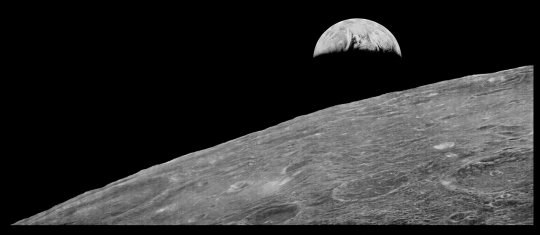
Image: This restored old image of Earth was released by NASA in 2008. The Lunar Orbiter 1 spacecraft took the iconic photograph of Earth rising above the lunar surface in 1966. Using refurbished machinery and modern digital technology, NASA produced the image at a much higher resolution than was possible when it was originally taken. Credit: NASA, Lunar Orbiter Image Recovery Project.
The thing about space exploration is that the wonders just keep coming, which invariably gets me to New Horizons and the image that provided my most recent perspective jump. Here we’re seeing the beautiful blue of Pluto’s haze layer through the New Horizons Multispectral Visible Imaging Camera (MVIC).
But of course the perspective jolt is in realizing that we’re seeing Pluto from behind. The Voyagers have traveled much farther than this, but not past Pluto, which for me had always been symbolic of the system’s ‘edge.’ To be looking at sunlight coming through its atmosphere from behind after the close flyby was an almost surreal experience.
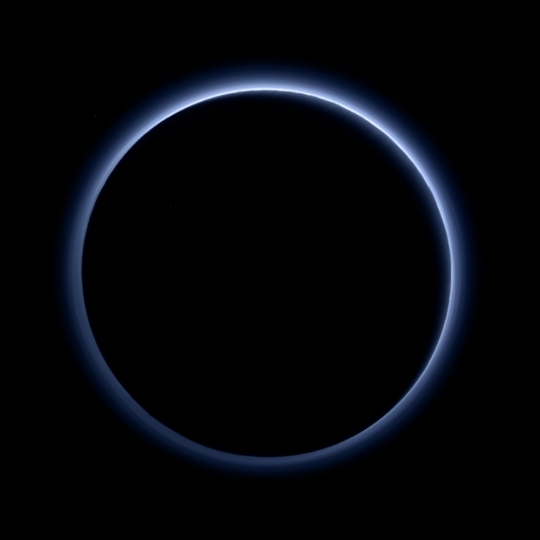
Image: The high-altitude haze at Pluto is thought to be similar in nature to that seen at Saturn’s moon Titan. The source of both hazes likely involves sunlight-initiated chemical reactions of nitrogen and methane, leading to relatively small, soot-like particles (called tholins) that grow as they settle toward the surface. This image was generated by software that combines information from blue, red and near-infrared images to replicate the color a human eye would perceive as closely as possible. Credit: NASA/JHUAPL/SwRI.
One more perspective changer takes us back toward Earth. It’s from the Deep Impact spacecraft, now re-purposed as EPOXI, a double-mission comprised of the Deep Impact Extended Investigation (DIXI) and Extrasolar Planet Observation and Characterization (EPOCh). Here again we’re looking at Earth and its Moon in a series of images showing the passage of the Moon between us and our planet. You’ll find more on EPOCh especially in the archives here, for the spacecraft has been used not only to study exoplanets but also to examine the Earth to help characterize planets like ours for future missions.
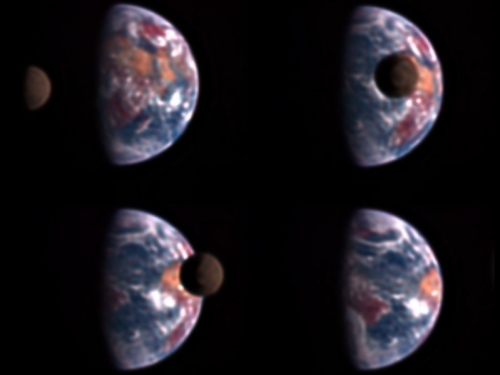
Image: Four images from a sequence of photos taken by the Deep Impact spacecraft when it was 50 million km from the Earth. Africa is at right. Notice how much darker the moon is compared to Earth. It reflects only as much light as a fresh asphalt road. Credit: Donald J. Lindler, Sigma Space Corporation, GSFC, Univ. Maryland, EPOCh/DIXI Science Teams.
But you knew the medievalist in me couldn’t resist pulling a far older reference on perspective into the picture. Below is one of the earliest paintings to use linear perspective, the work of Florentine artist known as Masaccio (1401-1428). It may not seem to have much in common with space missions, but consider this: The development of perspective in painting was the emergence of a far more realistic depiction of people amidst buildings and landscapes, a style that would be known as Florentine Realism and would fundamentally change visual art. How we look at ourselves in the world influences the values and character of a civilization.

Images cause us to see ourselves with fresh eyes, and in the spectacular imagery of our space missions, we get a gut-check on our place in the universe. Some people say that the famous ‘pale blue dot’ image made us realize how insignificant we are, but I have a much different take. The Voyager image below, taken when Voyager was 6 billion kilometers from home, shows Earth as a speck barely visible in the brown band to the right. When I look at it, what I see is that we are a species that was able to get out there and look back upon its own home world.
Going to other planets, going to the stars — there is nothing inevitable in any of this. These are choices we make, within the context of our values and our science. Images like these remind us how momentous our choices are.

Image: This narrow-angle color image of the Earth, dubbed ‘Pale Blue Dot’, is a part of the first ever ‘portrait’ of the solar system taken by Voyager 1. The spacecraft acquired a total of 60 frames for a mosaic of the solar system from a distance of more than 6 billion kilometers from Earth and about 32 degrees above the ecliptic. From Voyager’s great distance Earth is a mere point of light, less than the size of a picture element even in the narrow-angle camera. Earth was a crescent only 0.12 pixel in size. Coincidentally, Earth lies right in the center of one of the scattered light rays resulting from taking the image so close to the sun. This blown-up image of the Earth was taken through three color filters – violet, blue and green – and recombined to produce the color image. The background features in the image are artifacts resulting from the magnification. Credit: NASA/JPL-Caltech.
The MarCO team also has the ‘pale blue dot’ in mind, pointing to its own Earth/Moon image:
“Consider it our homage to Voyager,” said Andy Klesh, MarCO’s chief engineer at NASA’s Jet Propulsion Laboratory, Pasadena, California. JPL built the CubeSats and leads the MarCO mission. “CubeSats have never gone this far into space before, so it’s a big milestone. Both our CubeSats are healthy and functioning properly. We’re looking forward to seeing them travel even farther.”
The pale blue dot fills me with humility but also an exhilarating sense of the human drive to explore. And that brings me back to New Horizons, now closing on the Kuiper Belt Object MU69. ‘Ultima Thule,’ as it is known by the New Horizons team, is only about 30 kilometers in diameter and seems to be a close binary. On January 1, 2019 we will have a flyby of this object, the farthest ever to be visited by a spacecraft. Who knows what perspective changes that imagery may trigger?






May 15, 2018
Galileo Evidence for Plumes on Europa
Once again we take advantage of older databanks to tease out new information. Europa is the case in point this morning, with Galileo data — magnetic field and plasma wave observations from 1997 — being brought in as evidence for a water vapor plume rising from the surface. The Galileo flyby took the craft closer than 400 kilometers, where a brief spike in plasma density was detected along with a concurrent decrease in magnetic field magnitude and a bend in the direction of the field. The data are consistent with a plume interacting with Jupiter’s plasma outflow, and support earlier Hubble indications of possible plumes on the moon.
We have no firm measurement of the thickness of Europa’s ice, but if we are to get to that fascinating ocean now known to exist below the surface, we have to contend with penetrating it. Plumes from the interior would be helpful indeed, as Enceladus showed us at Saturn. Flying a spacecraft through a plume lets us measure its ingredients and sample the ocean below. So this new work, which has just been published in Nature Astronomy, offers the prospect of plume sampling via close flyby for upcoming missions like Europa Clipper.

Image: Artist’s illustration of Jupiter and Europa (in the foreground) with the Galileo spacecraft after its pass through a plume erupting from Europa’s surface. A new computer simulation gives us an idea of how the magnetic field interacted with a plume. The magnetic field lines (depicted in blue) show how the plume interacts with the ambient flow of Jovian plasma. The red colors on the lines show more dense areas of plasma. Credit: NASA/JPL-Caltech/Univ. of Michigan.
As it happens, lead author Xianzhe Jia (University of Michigan) is co-investigator for two instruments designed for Europa Clipper, and it was another member of the Europa Clipper science team, Melissa McGrath (SETI Institute) who prompted the deeper dive into Galileo data, inspired by the intriguing observations from Hubble. The space telescope was operating at the far edge of its capabilities, leaving the prospect of Europan plumes ambiguous, but the location of one of the Hubble ‘plumes’ turned out to be useful. Says Jia:
“One of the locations she mentioned rang a bell. Galileo actually did a flyby of that location, and it was the closest one we ever had. We realized we had to go back. We needed to see whether there was anything in the data that could tell us whether or not there was a plume.”
What Hubble observed at the site appeared to rise some 200 kilometers above the surface of Europa, consistent with the Galileo data. As the paper notes, Galileo acquired magnetomer data on eight targeted passes of Europa during its eight years in Jovian orbit, but only two of these passes came closer to the surface than 400 kilometers, a height at which a plume might give off both a plasma and magnetic field signature. As the paper notes:
Both passes crossed the trailing hemisphere of Europa (E12 near the equator and E26 at high southern latitude) and recorded short time-duration, large-amplitude perturbations accompanied by a sharp decrease of the field magnitude near closest approach. A previous study of the potential effect of plumes on Europa’s plasma interaction suggested that the magnetic perturbations during the E26 flyby could be associated with atmospheric inhomogeneity resulting from a plume. Here, we show that a localized signature in the MAG data acquired on Galileo’s closest encounter with Europa (E12 flyby) is fully consistent with the perturbations expected if the spacecraft crossed a plume rising above the nearby surface.

Image: This is Figure 3 from the paper. Caption: Location of the modeled plume on Europa’s surface. a,b, Perspectives from a longitude of 270° W (a) and from above the northern pole (b). The surface features shown on the sphere were extracted from a global map of Europa compiled by the United States Geological Survey. The cyan iso-surface of constant neutral density illustrates the shape and location of the modelled plume, and the magenta traces show the Galileo trajectory. The green ellipse in a indicates the location of a putative plume imaged by Hubble. Credit: Jia et al.
Certainly the experience we gained with Cassini at Enceladus has helped to investigate this phenomenon, for we know that material within the plumes, once ionized, has effects on the magnetic field similar to the bend in the field observed in the Galileo data. The spacecraft’s plasma wave spectrometer likewise proved useful, examining the interactions caused by charged particles above the Europan surface, and clearly demonstrating a spike in intensity.
Using 3D modeling tools developed by his team, Jia was able to simulate the interactions of plasma with bodies like Europa, producing simulated plumes that matched the Galileo data and were consistent with what Hubble had revealed.
“There now seem to be too many lines of evidence to dismiss plumes at Europa,” says Robert Pappalardo, Europa Clipper project scientist at NASA’s Jet Propulsion Laboratory in Pasadena, California. “This result makes the plumes seem to be much more real and, for me, is a tipping point. These are no longer uncertain blips on a faraway image.”
We can hope that Europa Clipper will get off as early as mid-2022, for its low-altitude flybys should allow us to sample dust particles and frozen liquid, a glimpse into the moon’s dark interior. As you would imagine, these findings have the Europa mission team examining orbital trajectories that will allow such measurements to be taken. The Europan plumes certainly aren’t as visible as the plumes of Enceladus, but if what Galileo encountered really was a plume during its eight-year mission, then plumes must be occurring on relatively short timescales.
The paper is Jia et al., “Evidence of a plume on Europa from Galileo magnetic and plasma wave signatures,” published online at Nature Astronomy 14 May 2018 (full text).






May 14, 2018
SETI: An Alternate Strategy
How would an advanced society communicate its history and values to the stars? Bill St. Arnaud argues that just as we can uncover our own history through careful analysis of archaeological sites, so SETI might uncover traces of ETI cultures in the form of signals that take advantage of natural astrophysical processes. Read on for more on an idea Bill first broached in a Centauri Dreams post called Virtual Von Neumann Probes. A consultant and research engineer, Bill’s work has involved everything from charging methods for electric vehicles to next generation Internet networks. But his interest in SETI continues to mesh with his expertise in networking in this examination of a novel way to speak from the deep past.
by Bill St. Arnaud

To date most SETI research has focused on the assumption that an advanced extra- terrestrial society will want to “communicate” with similar beings throughout the universe. But it is my belief that given the vast distances and time that communication via a “communications channel” even if it is one way, such as optical or radio frequency transmissions will be impractical.
Current SETI searches assume that an advanced civilization will use extremely powerful omni-directional transmitters or highly directional and focused signals targeted at our solar system. The challenge with either approach is the fact that successful one-way communication between intelligent species is the dependency on the “L” term in the Drake equation. L represents the length of time for which such civilizations release detectable signals into space. If L is relatively short then possibility of two separate intelligent civilizations being coincident in time to send and receive a signal is very small. So even though there may have been many intelligent civilizations we will probably never be aware of their existence.
Given these constraints I suggest instead that we look for extra-terrestrial intelligence in a similar way we searched for signs of intelligence on earth prior to the modern age. We cannot hope to communicate to prehistoric man, but we know that intelligent beings existed on earth thousands of years ago through archaeological evidence such as cave paintings, pyramids, monuments, etc.
More recently societies have been burying time capsules for future generations to discover and hopefully marvel at our accomplishments and perspectives of the future. Indeed several spacecraft have included time capsules to be hopefully discovered by humans or extra-terrestrial intelligent beings in the far future. Part of the Apollo 11 Lunar Module, still on the moon, includes a plaque showing the arrangement of the Earth’s continents in 1969. The LAGEOS satellite (which will re-enter the atmosphere in 8.4 million years) contains a plaque showing the arrangement of the Earth’s continents in the past, present, and future. Pioneer 10 and Pioneer 11 both contain plaques that give pictorial information about their time and place of origin. The two Voyager spacecraft each contain a golden record that contains pictures and sounds of Earth, along with symbolic directions for playing the record and data detailing the location of Earth.
The understandable challenge of physical time capsules is the probability of locating and/or discovering these time capsules by future generations or aliens. Given the vast distances of space it is highly improbable that these time capsules will ever be discovered by any kind of intelligent being.
So rather than deploying physical time capsules can we think of a way of deploying electromagnetic time capsules made from self amplifying or self re-generating optical and RF signals that propagate forever and are easily discoverable and locatable? SETI researchers, in the past, have often speculated on self replicating robots that could travel to distant planets and recreate themselves by using local materials, but the complexity of such a device boggles the mind. Self amplifying and regenerating electromagnetic signals on the other hand would conceivably be much easier to deploy and possibly be achievable with current technology.
Self amplification and regenerating signals could use natural physical process such as gravitational lensing, stellar corona pump amplification, orbital angular momentum and other techniques to propagate electromagnetic signals indefinitely. But rather than being a straight line propagation in the direction of the original signal, self amplification and regenerated signals may propagate in all sorts of random directions depending on the physical properties of the amplification and regeneration process itself. As such the signals may be bouncing around the galaxy from one star to another in no particular predetermined direction.
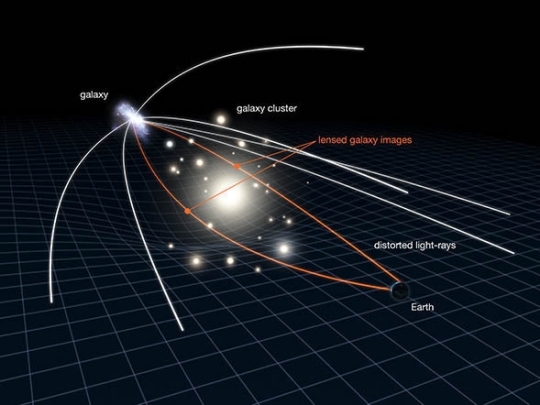
Image: An example of one kind of naturally occuring gravitational lensing, in this case involving galactic clusters. Lensing clusters are clusters of elliptical galaxies whose gravity is so strong that they bend the light from the galaxies behind them. This produces distorted, and often multiple images of the background galaxy. But despite this distortion, gravitational lenses allow for greatly improved observations as the gravity bends the lights path towards Hubble, amplifying the light and making otherwise invisible objects observable. Credit: JPL.
Given that they depend on natural physical processes for amplification and regeneration the originating transmission does not to be that powerful or directional. It is conceivable that low power transmissions are that all is required to launch a self amplifying and regenerating electromagnetic signal. The signals may also be in a part of the spectrum that is not usually commonly assumed for interstellar transmission but rather exist in parts of the spectrum associated with the physical amplification and regeneration process.
There are a host of problems with current interstellar electromagnetic signaling such as attenuation, dispersion, group delay, etc etc. Given these limitations how could we hope to deploy a self replicating optical signal that will maintain its integrity over the vast distances and time of space?
One intriguing possible solution is using gravitational lenses to refocus and amplify a interstellar electromagnetic signal. In an interesting post called The Gravitational Lens and Communications, Paul Gilster quotes the work of Italian physicist Claudio Maccone, who explains that a ‘Sun-Alpha Centauri direct radio bridge exploiting both the two gravitational lenses, this minimum transmitted power is incredibly… small! Actually it just equals less than 10-4 watts, i.e. one tenth of a milliwatt is enough to have perfect communication between the Sun and Alpha Cen through two 12-meter FOCAL spacecraft antennas.`
One should also note that a gravitational lens acts like a lens with a gradient refractive index which also collimate and reduce electromagnetic dispersion.
Other possible mechanisms for self replicating signals include RF Orbital Angular Momentum (OAM), quantum entanglement and using stellar corona as pump amplifiers. As an example see the recent post about solar corona masering. I am sure there are other possible candidates. I challenge the reader of this missive to think of other ways of creating self replicating electromagnetic time capsules.
If we can come up with a plausible mechanism for deploying self replicating optical/rf time capsules the next obvious step would be to see if we can detect any such phenomena in our local interstellar region.
Instead of searching for communications signal from an extraterrestrial intelligent civilization we should perhaps instead look for “archaeological” evidence of their existence with the most likely candidate being a easily discoverable self replicating electromagnetic time capsule.
If you have any suggestions or comments, or think I am completely nuts please feel free to contact me at Bill.st.arnaud@gmail.com






May 11, 2018
The Habitable Zone: The Impact of Methane
The definition of a habitable zone is under constant refinement, an important line of research as we choose which exoplanets to focus on in our search for life. Centauri Dreams regular Alex Tolley today looks at the question as it involves the presence of methane. With planetary warming already known to vary depending on the spectral type of the host star, we now learn that the presence of methane can produce thermal inversions and surface cooling on M-star exoplanets, impacting the outer limits of the habitable zone. The work of Ramses Ramirez (Tokyo Institute of Technology) and Lisa Kaltenegger (Carl Sagan Institute, Cornell University), the paper also suggests a possible biosignature near the outer habitable zone edge of hotter stars, one of several results that Alex explores in today’s essay.
by Alex Tolley

Alien world – still from 2001: A Space Odyssey. Credit: Metro-Goldwyn-Mayer (MGM)
As noted in previous posts on biosignatures, especially in regards to life prior to photosynthetic oxygenation of the atmosphere, methane (CH4) is a gas that appears early due to prokaryotic methanogens producing it at rates far higher than geological processes and sustaining its presence despite the chemical destruction. The presence of CH4 in a primordial N2-CO2-H2O atmosphere has been suggested as a component of a biosignature (Detecting Early Life on Exoplanets).
Which leads to the obvious question. As CH4 is a potent greenhouse gas, does it impact the size of the habitable zone (HZ), particularly its outer edge, which is usually defined by the greenhouse gas CO2? This is exactly the question that Ramirez and Kaltenegger try to answer in a new paper. Using their prior approach of assuming a rocky, Earth-like world around different star types, they approach the problem of modeling the effect of the star’s emission on the planet’s atmosphere with varying mixing ratios of CH4 from 10-100,000 ppm.
The authors have previously shown that the spectra of the star impact the warming of a planet [4, 5]. As the spectrum shifts towards the red, the warming efficiency increases. Because CH4, unlike CO2 and H2O, has strong absorption in both the infrared (IR) and near-infrared (NIR), this spectral shift has an even more pronounced effect when CH4 is an atmospheric component gas. For exoplanets with CH4 in their atmospheres around cool stars, the absorption occurs in the upper atmosphere, causing a thermal inversion and cooling the surface. Figure 1 shows the atmospheric temperature profile with altitude when 1% (10,000 ppm) of CH4 is added to a 3 bar atmosphere of CO2 for three star types: F0, our G-type sun, and M3. For both the F0 and G stars, the CH4 increases the surface temperature.20-30K. However, for the M3 star, the surface temperature is reduced by 30K as much of the energy is already absorbed at high altitude. Unlike most atmospheres, exoplanets around M-stars with a CH4 component have a temperature inversion. This has a direct effect on the outer limit of the HZ.
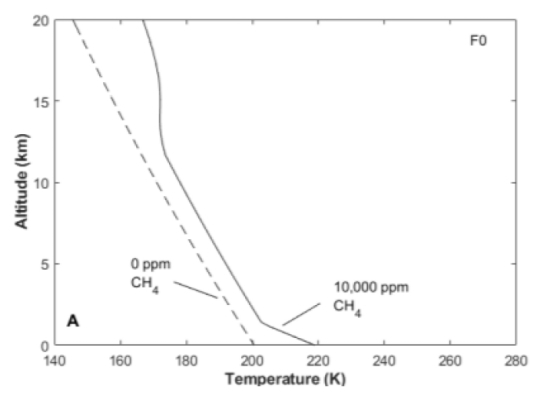
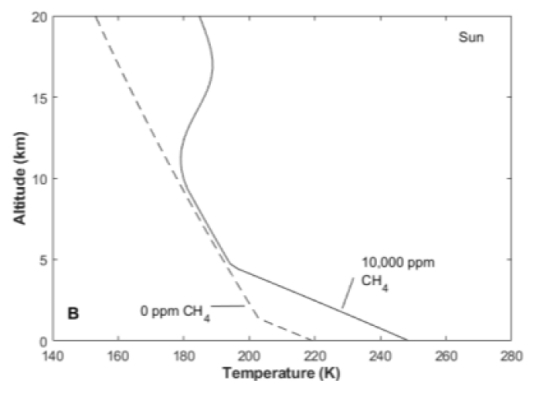
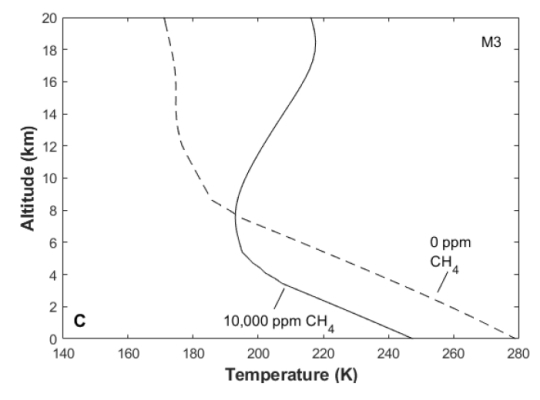
Figure 1. Changes in temperature profiles for a 3 bar CO2 atmosphere (S/So = 0.33) for a model planet with a surface pressure of about 4 bar orbiting a) an F0, b) a solar-analog, and c) an M3 host star when adding 1% (10,000 ppm) CH4. A temperature inversion forms for all three model planets when CH4 is added to the atmosphere. The surface temperature increases when 1% CH4 is added for the planet orbiting the F0 (18K) and solar analog (29K), but decreases for the planet orbiting an M3 star (31K).
Intuitively we expect that CH4 should extend the outer edge of the HZ for the F0 and G type stars as less energy is required to maintain a surface temperature above freezing (273K). For K3 stars and hotter, their model adding CH4 does indeed extend the HZ’s outer edge, quite substantially, while the inner edge remains fairly similar in distance from the star. However, because of the reduced surface temperature of the cooler stars, especially the ubiquitous M-types, CH4 reduces the range of the HZ, pulling the outer edge of the HZ closer to the star.
Figure 2 shows the effect of different mixing ratios of CH4 on the effective stellar flux (SEFF) needed to maintain a surface temperature above freezing against stellar types. Some cooler star exoplanets at the outer edges of their HZ zones are shown, indicating that some may have frozen surfaces if they have CH4 as an atmospheric gas component.
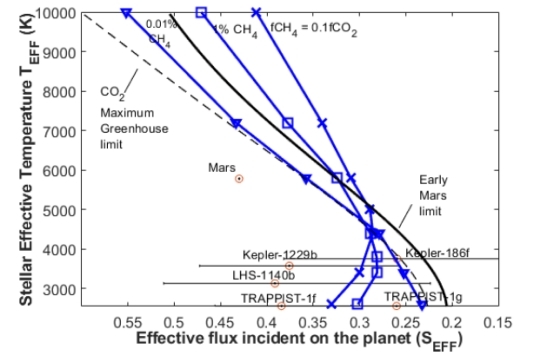
Figure 2. The effect of adding methane to the outer edge of the classical HZ. Stellar effective temperature versus the effective stellar flux (SEFF) for the outer limits of the Habitable Zone. The traditional outer HZ limit, the CO2 maximum greenhouse limit (dashed), is shown along with the empirical outer edge (solid black) and outer edge limits (solid blue) containing various amounts of CH4: 10 ppm (triangle), 1% (square), and fCH4 = 0.1 x fCO2. Some confirmed planets near the outer edge are included with error bars displayed.
The presence of CH4, therefore, has an impact on target exoplanet life. For Earth, CH4 might help explain the problem of the young, faint sun. When the earth was formed, the lower luminosity of the sun was insufficient to raise the surface temperature above freezing, yet life clearly evolved quite early. CH4 emission by methanogens during the Archean eon may have warmed the Earth’s surface sufficiently to have allowed liquid oceans and prokaryotes to evolve, and certainly ensured that an ice-free surface allowed photosynthetic blue-green bacteria to harvest solar energy.
Because CH4 extends the outer edge of the HZ for our sun, calculations suggest that early Mars was within the HZ if it had a dense CO2 atmosphere with a CH4 component. If so, this would support the theory of liquid seas on its surface and possibility that life also emerged to produce the needed CH4, or hydrogen (H2) to maintain its warmth as the atmosphere initially waned [6]. As the atmosphere was eventually largely stripped, the surface cooled and the seas froze to become the subsurface glaciers and frozen aquifers that we detect today, as well as the polar ice caps of frozen water and CO2. Whether life still exists below the surface is unknown, although there are tantalizing hints that just maybe methanogens are the source of the detected CH4 in the atmosphere, rather than geologic emissions.
The authors suggest that due to the far higher biogenic source of CH4, exoplanets around hotter stars on the edge of their HZ’s with detectable CH4 might well be evidence that they are living worlds. This is further bolstered by their model that shows CH4 levels can create a sort of Gaian “Daisy World” [2] where the surface temperature is maintained by processes that stabilize CH4 levels. Figure [3] shows this. Point P2 is stable as a declining CH4 level increases the surface temperature, increasing the CH4, while levels above that point reduce the temperature and reduce the emitted CH4.
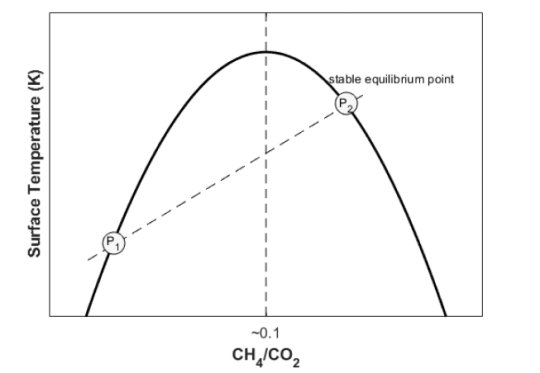
Figure 3. Proposed “Daisyworld” scenario for planets at the outer edge of the methane HZ with CH4 in their atmospheres orbiting hotter (~A – G class) stars. The curved lines illustrate the effect that the CH4/CO2 ratio has on surface temperature whereas the straight lines depict the effect that
temperature has on the CH4/CO2 ratio (adapted from Domagal-Goldman et al. 2008).
However, this is not the case with M-star exoplanets. The authors’ model suggests that for these worlds, the increased CH4 cools the planet resulting in a freezing surface which might well extinguish the development of life. Therefore on a planet at the outer edge of the HZ evolving methanogens will cool, freezing the surface. Life would be forced to retreat to oceanic vents and the lithosphere, precluding the emergence of photosynthesis, and energetic motile, multicellular life.
Another question also remains unanswered. M-star dwarf exoplanets orbit so close to their star that they are likely tidally locked. As we have seen previously, such warm wet worlds are also likely to have high cloud cover and therefore higher albedos [4]. Do those factors influence the results of this model? The authors hint that these conditions do matter quite significantly and will be explored in their next paper. Stay tuned!
References
1. Ramses M. Ramirez, and Lisa Kaltenegger, 2018, “A Methane Extension to the Classical Habitable Zone,” The Astrophysical Journal Vol. 858, No. 2 (7 May 2018). Abstract.
2. Andrew J. Watson, James E. Lovelock, 1983, “Biological homeostasis of the global environment: the parable of Daisyworld”, Tellus B, vol. 35B, no. 4, pp. 284-289 (abstract).
3. H. Lammer, J. H. Bredehöft, A. Coustenis, M. L. Khodachenko, L. Kaltenegger, O. Grasset, D. Prieur, F. Raulin, P. Ehrenfreund, M. Yamauchi, J.-E. Wahlund, J.-M. Grießmeier, G. Stangl, C. S. Cockell, Yu. N. Kulikov, J. L. Grenfell, H. Rauer, 2009, “What makes a planet habitable?”, The Astronomy and Astrophysics Review, vol. 17, no. 2, pp. 181-249 (abstract).
4. Sarah Rugheimer, Lisa Kaltenegger “Spectra of Earth-like Planets Through Geological Evolution Around FGKM Stars”, The Astrophysical Journal 854(1). Abstract.
5. Ramses M. Ramirez. 2014 “Terrestrial planets under extreme radiative forcings: applications to habitable zones, early Mars, and a high-co2 Earth.” Ph.D. thesis. Pennsylvania State University (abstract).
6. Ramses M. Ramirez, & Lisa Kaltenegger 2016. “Habitable Zones of Post-Main Sequence Stars.” The Astrophysical Journal, 823(1), 6 (abstract).






Paul Gilster's Blog
- Paul Gilster's profile
- 7 followers


